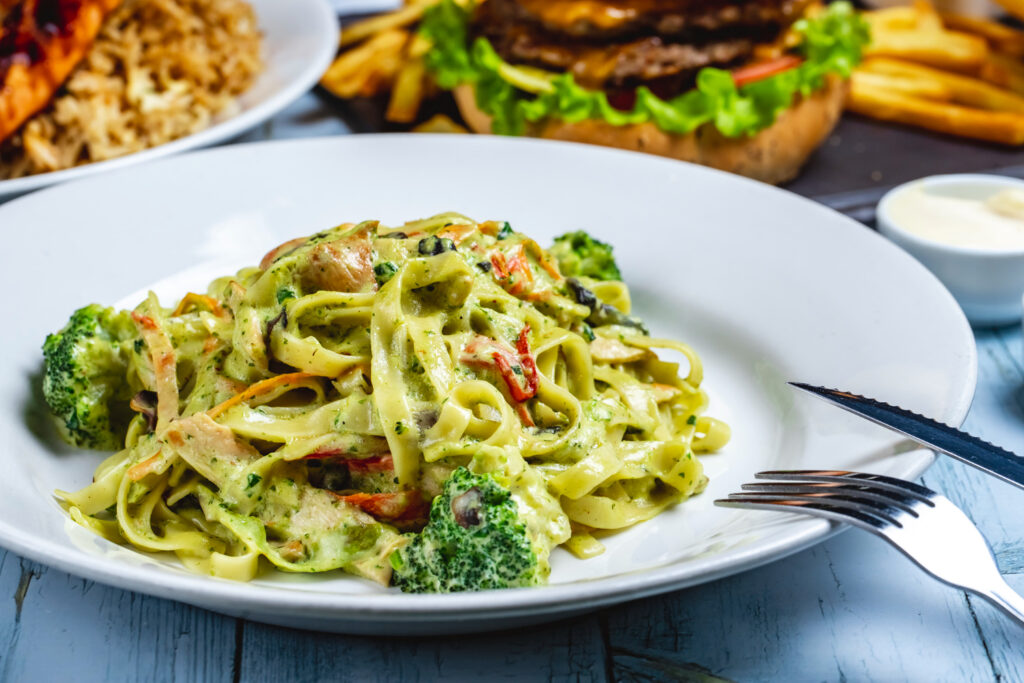Tagliatelle is one of the most famous types of Italian pasta. It is long, flat, and ribbon-like, making it perfect for holding rich and flavorful sauces. Unlike short pasta shapes, tagliatelle gives a sense of elegance to any plate, whether served in a restaurant or made at home. In simple words, tagliatelle is pasta shaped like ribbons, a little wider than spaghetti and traditionally made with eggs and flour.
This pasta has been loved in Italian cooking for centuries and has found fans all over the world. From traditional dishes in Bologna to modern plates in international restaurants, tagliatelle continues to show its versatility. It is cherished not only for its taste but also for its ability to carry tradition and culture in every bite.
In this guide, we will explore the story of tagliatelle, from its origins in Italy to the way it is cooked and served today. You will learn about its history, its defining features, how it is made, and why it remains such a timeless choice for pasta lovers everywhere.
The Origins of Tagliatelle
Tagliatelle has deep roots in Italian history. Its name comes from the Italian word “tagliare,” meaning “to cut,” because the dough is rolled out and then cut into long ribbons. This simple act of cutting transforms basic ingredients into a pasta that is now famous around the world.
The cultural background of tagliatelle is tied to family cooking and traditions. In the past, it was prepared by hand at home, usually for special meals or celebrations. Making pasta together was often a family event, with recipes and techniques passed down through generations.
Tagliatelle is strongly linked to the Emilia-Romagna region of northern Italy, especially the city of Bologna. Here, tagliatelle is more than just food — it is part of cultural pride. The people of Bologna even registered the official width of tagliatelle with the Bologna Chamber of Commerce to ensure its authenticity would be preserved.
Traditional Characteristics of Tagliatelle
Tagliatelle is unique because of its shape and size. The pasta ribbons are usually about 6 to 8 millimeters wide, with a flat surface that holds onto sauces very well. This width makes it slightly larger than fettuccine, giving it a distinct texture and bite.
The texture of tagliatelle is smooth yet firm when cooked properly, creating the perfect balance between tenderness and structure. Unlike spaghetti, which is thin and round, tagliatelle offers a richer mouthfeel.
One of the key differences between tagliatelle and other ribbon pastas is its identity. While fettuccine and pappardelle are similar in appearance, tagliatelle has its own balance of width and thickness that sets it apart. This is why authentic Italian recipes treat it as a pasta of its own rather than just another variation.
Ingredients Used to Make Tagliatelle
At its heart, tagliatelle is made with two simple ingredients: flour and eggs. The classic dough uses high-quality wheat flour and fresh eggs, giving the pasta a rich yellow color and a smooth texture. This simple recipe has stood the test of time, creating a base that pairs beautifully with many sauces.
In modern kitchens, there are variations that cater to different needs. Some cooks use semolina flour for a slightly firmer bite. Others experiment with gluten-free flours to make tagliatelle suitable for more diets. Vegan versions replace eggs with water or plant-based substitutes. While these may differ from tradition, they show the adaptability of tagliatelle in today’s cooking world.
How Tagliatelle Is Made
Traditionally, tagliatelle is handmade. The dough is kneaded until smooth, rolled out with a rolling pin, and then carefully cut into ribbons. Skilled cooks often fold the dough before cutting, which ensures even strips without much effort. The handmade process creates pasta that is slightly irregular, adding charm and character to each dish.
Today, many people buy tagliatelle from stores. Machine-made tagliatelle is widely available in both fresh and dried forms. Dried tagliatelle is popular because it lasts longer and can be stored easily, while fresh tagliatelle is prized for its softer texture and authentic taste. Both options have their place, depending on convenience and preference.
Famous Tagliatelle Dishes
Perhaps the most famous dish with tagliatelle is tagliatelle al ragù, also known as Bolognese. In Bologna, this combination of pasta with a slow-cooked meat sauce is a classic and represents Italian comfort food at its best. The wide ribbons hold the thick ragù perfectly, ensuring each bite is full of flavor.
Beyond Bolognese, tagliatelle is used in many seasonal and regional recipes. In spring, it might be paired with fresh vegetables and herbs. In winter, it can be served with truffle, mushrooms, or creamy sauces for a richer dish. These variations show how flexible tagliatelle is, adapting to both tradition and creativity.
Cooking Tips for Perfect Tagliatelle
Cooking tagliatelle may seem simple, but a few tips make a big difference. It is important to use plenty of boiling salted water to allow the pasta to cook evenly. Fresh tagliatelle usually takes only a few minutes to cook, while dried versions may need a bit longer. The key is to keep the pasta firm to the bite, known as “al dente.”
When it comes to pairing, tagliatelle is best with sauces that cling to its flat surface. Meat-based ragù, creamy mushroom sauces, or even light tomato sauces all work well. The balance between sauce and pasta is what makes tagliatelle shine.
Tagliatelle in Modern Cuisine
In recent years, tagliatelle has found its way into modern and creative cooking. Chefs experiment with different ingredients, such as seafood, seasonal vegetables, and even global flavors. For example, you may find tagliatelle served with Asian-inspired sauces or paired with spicy flavors from outside Italy.
This shows how adaptable the pasta is. While it remains tied to Italian roots, it has become a canvas for chefs worldwide. The ability of tagliatelle to blend tradition with innovation keeps it relevant in today’s dining scene.
Nutritional Profile of Tagliatelle
Tagliatelle, like most pasta, is a source of carbohydrates, which provide energy. The egg-based dough also gives it a small amount of protein and fat, making it slightly richer than plain flour pasta. One serving of tagliatelle is filling and satisfying, which is why it is often paired with nutrient-rich sauces to create a balanced meal.
From a health perspective, tagliatelle can be enjoyed as part of a balanced diet. Choosing fresh ingredients for sauces and keeping portion sizes reasonable allows pasta lovers to enjoy it without guilt. Whole-wheat and gluten-free versions also provide more options for those with specific health needs.
Storing and Serving Tagliatelle
Fresh tagliatelle should be stored in the refrigerator and eaten within a couple of days. It can also be frozen to last longer. Dried tagliatelle, on the other hand, has a much longer shelf life and can be kept in a pantry. Both forms keep their flavor well when stored properly.
When serving tagliatelle, presentation adds to the enjoyment. Twisting the pasta into neat nests on a plate and topping it with fresh herbs, grated cheese, or a drizzle of olive oil makes the dish look as good as it tastes. A well-presented plate of tagliatelle captures both tradition and elegance.
Conclusion
Tagliatelle is more than just pasta. It is a symbol of Italian tradition, a food that carries stories of families, regions, and centuries of cooking. Its ribbon shape makes it unique, its history makes it special, and its versatility keeps it loved across the world.
Whether enjoyed in a simple homemade dish or at a fine restaurant, tagliatelle never fails to impress. For anyone who loves pasta, it represents comfort, creativity, and culture on a plate.
FAQs
1. What is the difference between tagliatelle and fettuccine?
Tagliatelle is slightly wider than fettuccine, and traditionally tied to northern Italian cooking, especially Bologna. While similar, they are not identical.
2. Can tagliatelle be made without eggs?
Yes, while the classic recipe uses eggs, egg-free versions can be made with flour and water, often used for dietary preferences.
3. How long does fresh tagliatelle last?
Fresh tagliatelle usually lasts two to three days in the fridge. It can be frozen to last for several weeks.
4. What sauces go best with tagliatelle?
Tagliatelle pairs well with meat-based ragù, creamy sauces, mushroom-based sauces, and light tomato blends. Its flat ribbons hold sauce beautifully.
5. Is tagliatelle always served with Bolognese sauce?
No, while tagliatelle al ragù is the most famous, it is also served with seasonal and creative sauces, making it very versatile.




